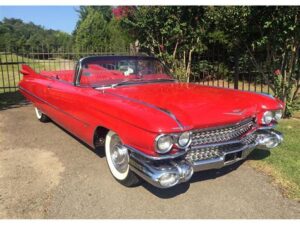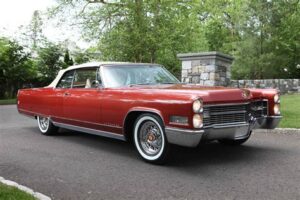When it comes to understanding vehicle performance and emissions control, one essential component often overlooked is the catalytic converter. Many car enthusiasts and everyday drivers alike may wonder, How many catalytic converters does my car have? This article aims to demystify this crucial aspect of automotive systems, providing clarity on the number of catalytic converters found in various vehicles and the factors that influence this. From dispelling common misconceptions to offering insights into optimal performance and replacement needs, we will delve into the intricacies of catalytic converters and their vital role in maintaining a vehicle’s efficiency and compliance with environmental standards. Join us as we explore the world of catalytic converters and discover the essential information every car owner should know.
Understanding How Many Cadillac Converters Are in Different Vehicles
When considering the question of how many catalytic converters a vehicle has, it’s essential to understand that the answer can vary significantly depending on the make and model of the car. Most standard passenger vehicles typically come equipped with one or two catalytic converters. However, performance vehicles or those with more complex exhaust systems may have additional converters installed.
For example, many modern vehicles with dual exhaust systems may contain two catalytic converters—one for each exhaust path. Additionally, some hybrid and electric vehicles may incorporate additional converters as part of their advanced emission control systems. It’s also worth noting that older vehicles, especially those manufactured before certain emission standards were implemented, may have fewer catalytic converters.
Here’s a brief overview of the number of catalytic converters in different vehicle categories:
| Vehicle Type | Typical Number of Catalytic Converters |
|---|---|
| Standard Sedan | 1-2 |
| SUV | 1-2 |
| Performance Vehicle | 2-4 |
| Hybrid Vehicle | 2-3 |
| Older Models | 1 |
When determining how many catalytic converters are in any specific vehicle, it’s advisable to consult the owner’s manual or a vehicle-specific database for accurate information. This ensures that you are fully aware of your vehicle’s emission system configuration, which can help in maintenance and when considering any repairs or replacements in the future.
Factors Influencing How Many Cadillac Converters a Car May Have
When considering how many catalytic converters a car may have, several key factors come into play. Understanding these variables can assist vehicle owners and enthusiasts in making informed decisions regarding emissions control and engine performance. Below are the primary influences:
- Vehicle Make and Model: Different manufacturers may opt for varying designs concerning catalytic converters. Luxury vehicles may have more than entry-level models to enhance performance and reduce emissions.
- Engine Configuration: The number of cylinders in an engine often dictates the number of catalytic converters. For instance, a V8 engine typically requires two converters to effectively manage exhaust gases.
- Emissions Regulations: Stricter emissions standards in certain regions can demand additional converters in a vehicle. Cars designed for states with stricter regulations may have additional catalytic converters to comply with laws.
- Aftermarket Modifications: If a car has undergone modifications, such as an upgraded exhaust system, it may include additional converters that alter the vehicle’s exhaust composition.
- Fuel Type: Vehicles running on diesel or alternative fuels may have different setups than traditional gasoline engines, often resulting in a different number of catalytic converters.
By considering these factors, vehicle owners can better grasp how many catalytic converters their car might require, allowing for better maintenance and compliance with regulations.
Common Mistakes About How Many Cadillac Converters Exist per Vehicle
When it comes to understanding how many catalytic converters a vehicle has, several misconceptions can lead to confusion. Here are some of the most common mistakes:
By being aware of these common mistakes about how many catalytic converters exist per vehicle, car owners can better understand their vehicles and make informed decisions regarding maintenance and repairs.
How Many Cadillac Converters Are Optimal for Engine Performance
When it comes to optimizing engine performance, understanding how many catalytic converters are needed is crucial. The optimal number of catalytic converters largely depends on the vehicle’s design, engine size, and emission regulations. Here’s a breakdown of what you should consider:
| Vehicle Type | Optimal Number of Catalytic Converters |
|---|---|
| Standard Passenger Vehicles | 1-2 |
| High-Performance Sports Cars | 2-4 |
| SUVs and Trucks | 1-3 |
| Hybrid Vehicles | 1-2 |
In essence, most standard passenger vehicles usually require one or two catalytic converters to efficiently meet emission standards while maintaining engine performance. However, high-performance vehicles typically benefit from having two to four converters to optimize exhaust flow and reduce back pressure. SUVs and trucks may have varying needs based on their size and engine type, while hybrids still adhere to the standard norms but might employ a different technology approach.
Consulting with your vehicle’s manufacturer guidelines or a professional mechanic is advisable to ensure you have the correct number of catalytic converters for optimal performance.
Determining How Many Cadillac Converters You Need for Replacement
When it comes to replacing your vehicle’s catalytic converters, it’s essential to understand how many converters your car requires. The number of converters can vary based on the vehicle’s make, model, and engine design. Here are some key points to consider while determining the right number for replacement:
| Vehicle Type | Typical Number of Catalytic Converters | Notes |
|---|---|---|
| Standard Passenger Cars | 1-2 | Most have one main catalytic converter; some may include a second for emissions reduction. |
| Trucks and SUVs | 1-3 | These might feature multiple converters depending on engine size and configuration. |
| High-Performance Vehicles | 2-4 | Often configured for higher emissions compliance; may include aftermarket modifications. |
| Hybrid Vehicles | 1 | Typically have one converter due to their efficient operation. |
To determine how many catalytic converters your vehicle has, start with the following steps:
1. Check the Owner’s Manual: This is the most direct way to find specific information about your vehicle.
2. Inspect Under the Vehicle: A visual inspection can confirm the number of converters fitted underneath.
3. Consult a Mechanic: A professional can provide clarity on your vehicle’s specific setup and requirements for replacement.
4. Perform an OBD-II Scan: This scan can reveal any fault codes related to the catalytic converters, which can hint at the presence of multiple converters.
Understanding the exact number of catalytic converters is crucial for effective repairs and to avoid any potential emissions-related issues that could arise from incorrect replacements. If in doubt, consult your vehicle’s documentation or a trusted mechanic to ensure compliance with local regulations and optimal engine performance.
Frequently Asked Questions
What is a catalytic converter?
A catalytic converter is an essential component of a vehicle’s exhaust system that reduces harmful emissions by converting toxic gases into less harmful substances.
How many catalytic converters does an average car have?
Most average cars typically have one catalytic converter, but some performance vehicles and certain models might have two or more.
What factors determine the number of catalytic converters in a vehicle?
The number of catalytic converters in a vehicle depends on its engine configuration, emissions standards, and design. For instance, vehicles with dual exhaust systems may have more than one.
Can a car run without a catalytic converter?
While a car can technically operate without a catalytic converter, it is illegal in many areas and will result in increased emissions and potentially damage to the engine.
What are the signs of a failing catalytic converter?
Signs of a failing catalytic converter include decreased engine performance, increased emissions, a check engine light, and unusual noises from the exhaust.
How do you maintain a catalytic converter?
Maintaining a catalytic converter involves regular engine maintenance, ensuring proper fuel quality, and addressing any engine issues promptly to prevent damage.
Is it expensive to replace a catalytic converter?
Yes, replacing a catalytic converter can be quite expensive, often ranging from $1,000 to $2,500, depending on the vehicle’s make and model.





